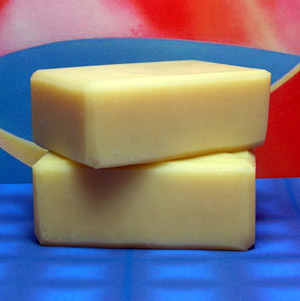Basic Recipe For Milk-Based Soap
 3 pounds pure vegetable shortening
3 pounds pure vegetable shortening- 17 ounces extra-light olive oil
- 12 ounces safflower oil
- 8 ounces canola oil
- 3 pounds (or 6 cups) goat or cow milk, prepared for soapmaking
- 12 ounces pure sodium hydroxide (lye)
- 1 ounce borax
- 1/2 ounce white sugar
- 1/2 ounce glycerin
- 16-ounce glass measuring cup
- 2 plastic or stainless-steel spoons
- 2 quart stainless-steel saucepan
- 2 (8-quart) stainless-steel pots
- 4 quart stainless-steel pot
- Molds (Vinyl window expanders work wonderfully)
- Plastic ladle
- Paring knife
- Digital Scale
- Plastic wrap and newspaper
- Glass candy thermometer
- Plastic spatula
- Silicone bakery paper for mold liners
- Spray-on corn oil to lubricate mold liner
- Putty knife
- Eye dropper to measure essential oils
- Blender
Preparing milk
Two important procedures must take place to "prepare" milk for soapmaking.
First, it must be pasteurized. Commercial milk has already been pasteurized; raw goat or cow milk can be pasteurized by slowly heating to 155°F (68°C), holding at that temperature for 1 minute, then covering and allowing to cool.
Second, it must be frozen and then thawed before use. Freezing increases its stability and makes it less vulnerable to the ravages of the lye. Pour into freezable containers (not glass), leaving 1/4 empty for expansion. Freeze until solid, then thaw out the day before using.
1. Observe soapmaking safety recommendations by wearing safety glasses and rubber gloves at all times during the process. Prepare your work area, laying out newspaper and making sure all ingredients and equipment needed are within reach.
2. Melt the vegetable shortening in an 8-quart pot over low heat.
3. Weigh out liquid oils carefully on a digital scale; add to the shortening. Heat until shortening is completely melted, then immediately remove from heat. Set aside until step 9.
4. Fill your sink with cold water. Add 4 to 6 trays of ice cubes.
5. Put the cold milk into a 3- or 4-quart stainless-steel pot. Carefully place into the ice water. Stabilize the floating pan by placing several plastic cups filled with water around it.
6. Using the digital scale, carefully measure 12 ounces of lye into a 16-ounce glass measuring cup.
7. Very slowly pour the lye into the cold milk, stirring constantly with a heavy-duty plastic spoon. This process should be done slowly, spanning no less than 15 minutes. Pouring too quickly will scorch the milk, rendering it useless.
8. It's important now to gauge the temperature of the lye/milk mixture so that it does not drop below 80°F (27°C), and to keep stirring. Remove from the cold-water bath as soon as the lye and milk are combined. The milk will turn a bright yellowish color if the process has been successful; if unsuccessful, it will congeal into a custard-textured mass.
9. Over low heat, reheat the oils to a temperature of 125°F (52°C). Remove from heat.
10. Slowly pour lye/milk mixture into the oil. Add the borax, sugar, and glycerin. Stir constantly, being careful not to splash any on your skin. You will probably notice the lye/milk mixture refusing to join with the oils if you stop stirring. Be patient.
11. The blender is an invaluable tool for making milk-based soaps from this point on. It forces the lye/milk mixture and the oils to join together. Use a plastic ladle to scoop evenly mixed amounts of the mixture from the pan into the blender. Fill the blender halfway, and secure the lid carefully before switching it on. Blend for 1 minute, while stirring the remaining contents in the pan at the same time. The liquid in the blender will become a lovely pale cream color.
After 1 minute, pour the contents of the blender into another 8-quart pan. Now you will need to stir both pans and run the blender--you may want to employ a partner. Repeat the process with the remaining mixture until all of the original mixture has been blended.
12. Quickly wash out the first sauce pan, dry it well, and repeat the whole process. It is during this second blending that you can add fragrance or essential oils, or specialty ingredients such as herbs or grains. You will now see little or no separation of the oils from the rest of the mixture. It will have thickened up somewhat, but even if it seems a little thin, it will still be ready to pour. If it seems too thin, you may want to repeat the blending process a third time.
13. Pour mixture into prepared mold and screed the top surface. (Pull the flat edge of a large putty knife or spatula across the entire surface of the mold to even out the mixture.)
14. Allow the liquid to sit uncovered and undisturbed in a draft-free area. After 12 hours you may notice sweatlike beads on the surface. This occurs occasionally and is nothing to worry about. Wipe off those that don't evaporate on their own after 24 hours.
15. Cut into bars after 24 hours, then allow cut soap to remain in the mold for another 24 hours, or until it is solid enough to hold its shape when removed. Allow bars to cure for 6 weeks in a dry, cool room. Cover lightly with plastic wrap to protect from dust.
makes 32 (4-ounce) bars